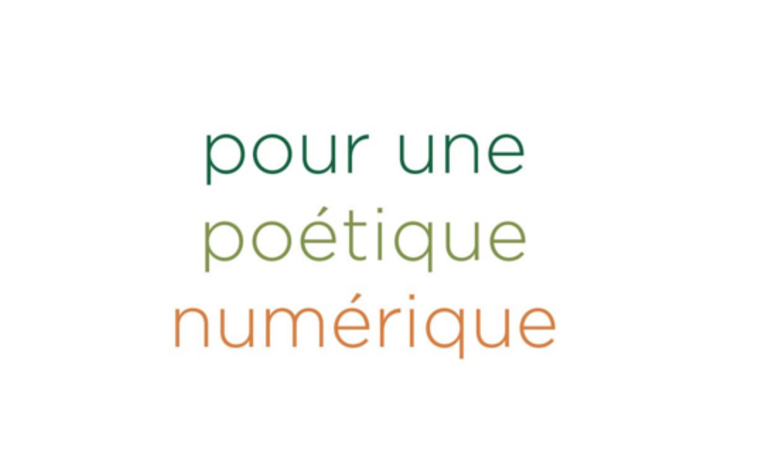Digital Writing: Transmedia versus Storytelling?

Gilles Bonnet, Pour une poétique numérique. Littérature et internet . Paris, Hermann, 2017 ISBN : 9782705694975
The new book by Gilles Bonnet on the poetics of digital writing –not in general but as an artistic practice– is an absolute must-read. It gives a well-informed, jargon-free and attractively written overview of the contemporary scene, striking a right balance between theoretical reflection and critical close-reading. It also proves that it is possible to undertake this kind of research by relying on a primary and secondary corpus that is not in the very first place Anglophone. Bonnet’ work on digital writing as it is happening today in France can and should be taken as an example by all those eager to reflect on digital culture in their own language. Bonnet’s book demonstrates that there is more to learn from a fresh approach of local and glocal cases than from the umpteenth second-hand and watered-down compilation of an amazingly small set of Anglophone works and authors (as we all know, no field has been canonized in so terrifyingly fast and narrow ways than that of electronic writing).
Pour une poétique numérique is also a truly original work, which addresses issues that most studies on electronic writing fail to take into account. Some of these issues can be called semiotic, such as the blurring of boundaries between words and images. Bonnet pays a lot of attention to the use of photographs by the new type of digital authors he calls “écranvains”, a portmanteau word mixing “écran” (screen) and “écrivain” (writer). For him, these “screen-writers” or “scriters” –no, the word is definitely too ugly– signify the return of the post-World War Two “camera-pen” (caméra-stylo) aesthetics, an aesthetics that has longtime be seen in antagonistic terms (“camera-pen” authors were those who swapped their pen for a camera, not those who did simultaneously both the writing and the filming) but that has now become a daily practice, as shown by almost all writers’ blogs. Other issues are institutional, such as the spread of the “residency” system in the digital era, a kind of modern sponsorship that offers the author a grant in exchange for a web-documented stay in some city or arts center. Institutionally speaking, the residency has become a criterion of distinction that replaces the no longer really functioning editorial gatekeeper system (since everybody can access the net and get published online, authors and readers are looking for new systems that help make distinctions, and the residency is one of them). Still others, finally, are literary in the broad sense of the word, such as the emergence of new genres (Bonnet is mainly interested in the autobiographical blog and author’s website) or the radical transformation of existing genres, in the first place the essay, which Bonnet rightly identifies as fundamentally linked with the very characteristics of digital writing. Writing on screen provokes a shift from the final product to the open an virtually unending process of both individual and collaborative writing and file-processing (words, images, sounds), and this shift brings the essay (in Bonnet’s terms, the “e-ssay”) to the center of literature.
For Bonnet, digital writing is inextricably linked with the work on transmedia storytelling. However, his approach is very different from what the currently dominating meaning of this term involves. On the one hand, transmedialization in digital writing does not necessarily implies the actual split between various works and media. What digital writing shows, is that the tendency toward a larger mediatic gamut –the writer is no longer just a writer, he or she is also photographer filmmaker, sound engineer, archivist, etc. – is perfectly compatible with the longing for a unified composition, even if the rapid expansion of a writing networks is always in danger of becoming hopelessly decentered (the critique that books produce an “artificial unity”, as some digital prophets liked to say thirty years ago, is a hollow one: culture is by definition “artificial” and moreover decentering is much easier and therefore less interesting than re-centering). In that sense, digital writing helps us rethink transmediality in light of intermediality, which may prove the more fundamental category.
On the other hand, digital writing also displays the obstacles raised to narrative and narrativity. Although it cannot be denied that narrative continues to be the master cognitive framework of the reader’s approach to digital writing, this writing itself is structurally speaking anti-narrative. Digital writing is permanently victim (true, often a rather consenting one!) to disruption, digression, interruption, dead end, repetition and breaking down, and this frailty in terms of sequential continuity is fundamentally at odds with the narrative drive or impulse. In this sense, digital writing is closer to what is called elsewhere the “cinema of attraction”. As the history of cinema makes clear, the aesthetics of attraction can be as challenging and inspiring as that of narrative, but we should be aware of the fact that narrative is not the natural horizon of digital writing. If there is narrative in it, it is because it has been (yes, artificially) constructed, not because our machines make us tell stories.
To finish, some words on the critical dimension of this book. Bonnet is not afraid of criticizing certain aspects and products of digital writing. Not because there are works and authors he dislikes (he has the elegance to avoid any personal attacks), but because digital writing involves certain structures and mechanisms that engender serious problems for all those wo dare take the risk to become screen-writers and to write digital-born works. Bonnet does not fall prey to naïve praise: his analysis of the residency system is ruthless, for instance (and one feels vicarious shame for all the authors who are forced to more or less hypocritically play a game that most of them have never chosen). The most crucial issue is however that of “quality”, for even if it is often difficult to define what this term means, most readers feel that quality is not always present in what they are reading (and they show what they feel by stopping to read the often endless blogs and sites that try to invent the new forms of writing in the digital era).
The reasons of this failure are not unknown. First of all, digital writing reshuffles the traditional mechanisms of literary mediation and selection (and without selection and mediation, culture, which is a social phenomenon, is simply not possible; for an analysis of the selection issue in the pocket book industry, see Jan Baetens: “Les livres de poche: une littérature exposée”, in Image (&) Narrative 18(4), 2017). The classic gatekeepers are no longer capable of (partially) controlling publication and reception, and this prompts much confusion: quality markers have to be reinvented, while the number of available texts is literally beyond any control (not only because too many works are put online, but because these works tend to become too long). Second, digital writing is by definition experimental and one cannot know in advance the rules and best practices of what is now being explored by trial and error. Yet this uncertaintly should not be a blanco cheque for anything goes. There is trouble in paradise and we have to say it. Bonnet clearly identifies all these problems, while resisting the temptation to build a canon. One can only hope that his example will be followed and implemented. Digital writing is not only in need of great apologists. It also needs critics fighting the silly idea that something is valuable because it is digital-born. That kind of technodeterminism may have been necessary when digital writing emerged in the literary field. Today, however, it has become harmful.

